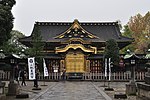Nezu Station
Internal link templates linking to redirectsRailway stations in Japan opened in 1969Railway stations in TokyoStations of Tokyo MetroTokyo Metro Chiyoda Line

Nezu Station (根津駅 Nezu-eki) is a metro station on the Tokyo Metro Chiyoda Line located in Bunkyo, Tokyo. Its station number is C-14. It opened for service on December 20, 1969.
Excerpt from the Wikipedia article Nezu Station (License: CC BY-SA 3.0, Authors, Images).Nezu Station
Shinobazu-dori Avenue, Bunkyo
Geographical coordinates (GPS) Address External links Nearby Places Show on map
Geographical coordinates (GPS)
| Latitude | Longitude |
|---|---|
| N 35.717376 ° | E 139.765744 ° |
Address
根津
Shinobazu-dori Avenue
113-0031 Bunkyo
Japan
Open on Google Maps










